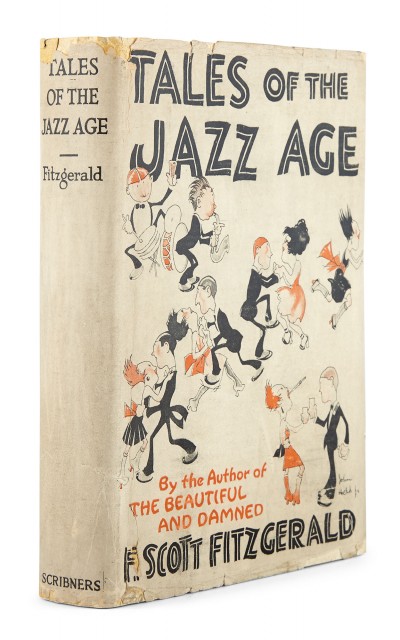F. Scott Fitzgerald and his Jazz Age
11/05/2018 Books & Autographs

NEW YORK, NY -- Just the mention of the name F. Scott Fitzgerald evokes the bright lights and green lawns of the Roaring Twenties. A term coined by him in 1922, Fitzgerald’s "Jazz Age" played out in the rarified worlds of the Princeton campus, the speakeasies of Manhattan, the mansioned North Shore of Long Island, and the French Riviera. Fitzgerald was the great chronicler of his post-WWI lost generation, the stories and novels as much about him and Zelda as it was about Gatsby and Daisy, Dick and Nicole Diver, Gerald and Sara Murphy.
Featured in the November 13, 2018 auction is a fine group of books by Fitzgerald, the popularity of whom among collectors has only risen with the passing decades. His first published book of short stories, Flappers and Philosophers (lot 165), is rarely encountered inscribed by the author and is here fluidly presented over a full page length to his friend Burton Whitney. Fitzgerald has jokingly signed in the name of the turn-of-the-century Swedish author Selma Lagerlof (here misspelled Lageroff!) above a true singing of his name in parentheses. The stories in this volume include some of Fitzgerald's best including the aptly titled, the very modern confidence builder "Bernice Bobs Her Hair." Flappers sold very well and was rapidly reprinted yet is the most uncommon of all Fitzgerald's works to be encountered inscribed.
In the 1920s it was not uncommon to discard the flashy dust jackets that protected a new book, even the eye catching cover of Fitzgerald’s 1922 Tales of the Jazz Age (lot 166). The cover is justly iconic: well-dressed flappers dance ecstatically with slicked-haired tuxedoed gentlemen, a fellow in the corner cuffs a flask behind him as he clinks glasses with a woman, her cigarette extended by long holder. Another copy, also inscribed to Whitney, is signed by Fitzgerald above the embellishment “le Maestro,” a nod to the high Fitzgerald must have been on during this heady period. In just two years, his lost generation had become the “swell set,” the roar of the decade nearing full blast.
Exhausted by the fully actualized “Jazz Age,” by 1924 Fitzgerald set his sights on a new novel and withdrew his family to the North Shore of Long Island to find it. The result was The Great Gatsby, published in 1925 (lot 167). Now considered the most emblematic novel of the period, the settings of the novel appealed to his devotees but the more serious themes failed to win over many critics and the novel sold rather poorly. Today though it is this work which is Fitzgerald’s most widely read and the most popular with collectors.
As a follow up to Gatsby, in 1926 Fitzgerald’s publishers, the literary powerhouse Charles Scribner’s Sons, attempted to invigorate interest in the author and issued another collection of short stories, All the Sad Young Men (lot 168). The subtle Art Deco artwork to the jacket is timeless: a classically draped young woman, looking longingly into the distance, holds up a reflective orb, a symbol of the world. Fine copies of this dust jacket such as the one offered are rare.
Finally, Fitzgerald’s last completed novel was nearly a decade in the making, his languid tale of the Riviera, Tender is the Night (lot 169). The novel is dedicated to and loosely about his bohemian expat friends, the Americans Gerald and Sara Murphy, the famed couple who first convinced the Hotel du Cap to stay open for the summer before settling in a villa in Cap d’Antibes. The dust jacket of the novel features a wraparound view of these villas that overlook the blue Mediterranean, a birds-eye view of the novel’s glamorous setting. Fitzgerald considered Tender is the Night his masterpiece, surpassing even Gatsby, but again reviews were mixed, and by the late date of 1934 his voice was not considered modern or new to the new generation.
Everything would change for Fitzgerald in his final years. His beloved Zelda came to live in institutions. Fitzgerald would try his hand at screenwriting in Hollywood but was never successful, seen as a throwback to a previous era. He died in 1940 and did not enjoy the revival of interest in his books, which began just a few years later when Gatsby was issued in great numbers in wartime editions to bored, aspirational G.I.’s in WWII. Within five years of his death, readers began the process which has canonized Fitzgerald as one of the top writers of the century, and this momentum has never ceased. Thus it is a rare opportunity to have most of F. Scott Fitzgerald’s published works offered in this one auction so that this publication history can be explored.
Rare Books, Autographs & Maps
Auction Tuesday, November 13, 2018 at 10am
Exhibition November 10 - 12